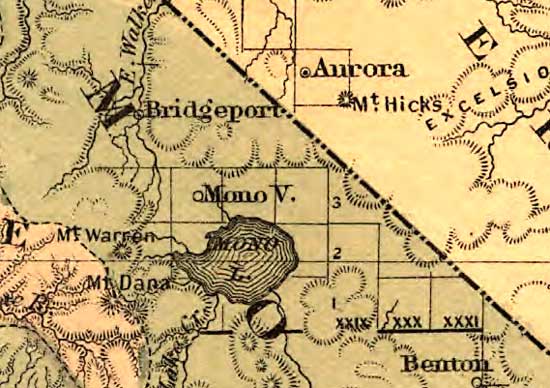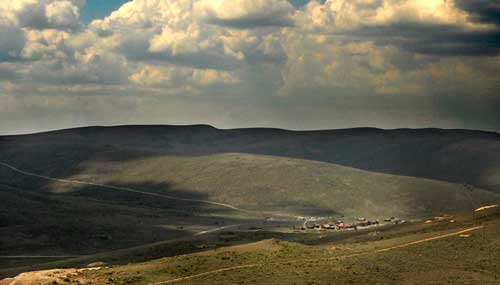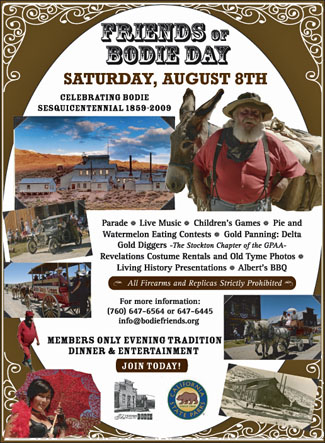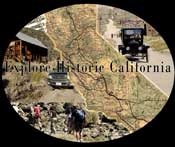|
Ten years after
the discovery of gold at Sutter’s Mill in the foothills of the
western Sierra Nevada Mountains, ore strikes on the eastern slopes
of the same great mountain range began sparking interest. Thousands
of prospectors, still with dreams of getting rich, migrated to
Nevada's Comstock Lode.
A small number
of men wound up in the Mono Lake region to try their hand at placer
mining. A few miles to the north of Mono Lake, at the headwaters of
the East Walker River, Dogtown was born. By mid 1859 a party of four
Argonauts took off from the newly sprouted community of Monoville
into the unexplored hills north of the large salt lake.
These four men,
Pat Garraty, William Boyle, Terrence Brodigan, and W.S. Bodey,
ventured across the California state line into what was then Utah
Territory. Indian trouble forced the four back to Monoville but did
not prevent them from digging prospect holes and finding promise
along the way. Brodigan, Garraty and Boyle held out until winter
arrived, with hopes of returning in the spring when the snows
melted. Only Bodey would return, this time with a half Cherokee
known as Black Taylor.
In October,
1859, Judge Keever of Monoville saw Bodey and his new partner,
Taylor, come in with rich sacks of dirt. The excitement sent others
rushing to the Silver Hill area 13 miles deep into the mountains
where Bodey and Taylor had staked their claim. Brodigan, from the
first party, had already lead one group back to Sonora, and was now
on his way with another. This group ran into Bodey and Taylor
traversing in the opposite direction on foot with single pack animal
and provisions from Monoville.
 |
|
Detail from
Thompson & West 1876 topographic map of
California and Nevada showing location of Monoville (Mono
V.).
Map courtesy David Rumsey Historical Map Collection |
The bitter
Eastern Sierra winter was threatening as the two groups passed each
other. Bodey and Taylor continued to Silver Hill where their mine
was, but the blizzard was taking over. The pass to Sonora was
reported closed with snow. Even those that chose alternate routes
out of Bloody Canyon, Walker’s Pass and Placerville barely made it
through.
The Comstock
communities of Gold Hill and Virginia City, only a mile apart from
each other, were cut off by snow more than six feet deep. Cattle,
horses, donkeys and various other animals were dying from cold and
hunger. Winters were harsh in this area and this winter was
particularly noted for being one of the worst.
W. S. Bodey and
Black Taylor continued on, struggling through howling wind and heavy
snow fall. Bodey eventually succumbed to the storm, and sunk in the
snow. Taylor, still fighting against the storm, tried to carry Bodey
all the way.
Somewhere in or
near Cottonwood Canyon, Taylor could no longer carry his partner.
Bodey was wrapped in a blanket and abandoned while Taylor continued
the trek to their primitive cabin by himself. There he rested up and
set out again when he was fully refreshed. The blizzard continued to
rage as Taylor searched for Bodey to no avail.
 |
|
View of Bodie
(center) from atop Queen Bee Hill. Perhaps W. S. Bodey
gazed from the same location. |
The severe
winter forced Taylor and other prospectors out of Silver Hill until
spring time when mining could resume. In late May, Taylor began his
search for W. S. Bodey. Johnson King, who helped with the burial,
described the physical remains as being stripped off by coyotes,
bones scattered, and minus an arm. A grave was dug three and one
half feet deep, running northeast and southwest in length, with the
feet of Bodey pointing toward the bluff which would be named after
him.
History argues
over the man who first discovered color in the Bodie Hills. We may
never know whether his first name was Wakeman, Waterman, William, or
some other variation beginning with the letter W. The spelling of
his last name was changed to Bodie, as opposed to Bodey, for
reasons which aren’t entirely known either.
A claim notice
was found “folded up and stuck in the fork of a bush” with the name
W. S. Bodey. In 1860 when a ranch located between Aurora and
what is now the town site of Bodie, ordered up a sign, the spelling
came back Bodie Ranch and people adopted that spelling. Some
say the ‘ie” was adapted to avoid confusion in how the name was
pronounced.
Even poor W.
S.’s burial site was lost for some years, only to be rediscovered in
1871, and forgotten all over again until October 26, 1879 when Judge
J. G. McClinton and Joseph Wasson exhumed the skeleton. The body
was left on display for the good citizens of the town baring his
name to mull over for awhile. Elaborate services took places,
complete with oration. A monument was ordered and forgotten; later
to be erected in memory of assassinated President James Garfield.
 |
|
The most
prestigious grave marker in Bodie's cemetery was
supposed to be for old W. S. Bodey, but was, instead,
dedicated to U.S. president James Garfield who died in
1881 after only four months in office. Bodey's body lies
somewhere beneath the sagebrush in an unmarked grave. |
The mysteries of
W. S. Bodey, who he was, where he came from, and what happened to
his body and the monument that was made for him, are just a small
part of the story of the diggings near Silver Hill that turned into
a thriving isolated metropolis of sorts, with an arguable population
of anywhere from 5000 – 10,000 citizens.

This year, 2009,
marks the 150th anniversary of the discovery of the
town. The ore that was pulled out, the men who mined it, the women
who followed them and more will be depicted throughout the decades
on August 8. The cast of characters from Bodie’s history will live
once again and you can meet them in person as they walk down the
dusty streets of the nearly abandoned town. Friends of Bodie members
will be treated to a private bbq and special events as the day comes
to a close.
It is unknown at
this writing what will become of Bodie State Historic Park in the
grand scheme of the state of California and its current budget cuts.
If you can’t attend The Friends of Bodie day, the park will remain
open at least through Labor Day. Plan a visit, sign petitions, write
letters, join the Friends of Bodie, donate time or money, and spread
the word about this unique remnant of California history.
|
